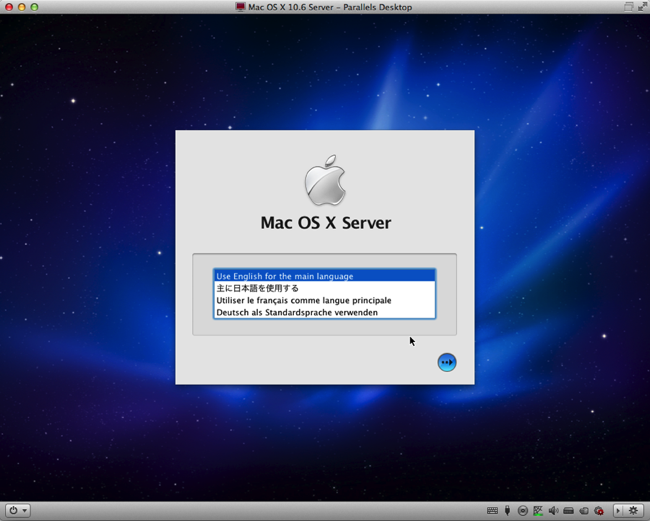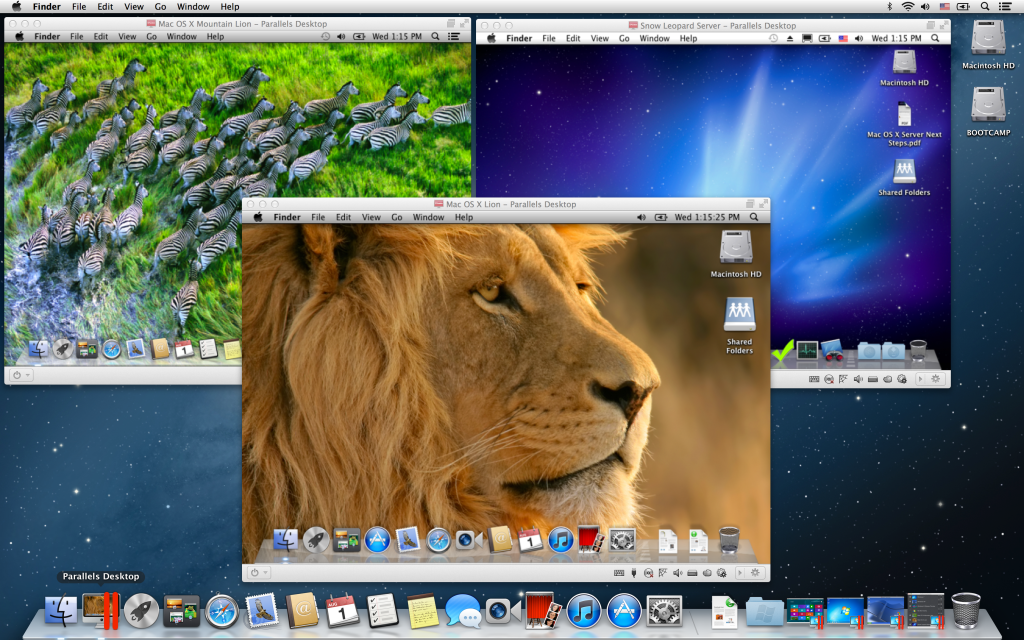We would like to upgrade to the new snow leopard os. However we are presently running parallels desktop 3.0 for mac on the os x leopard software. Part of the decision to upgrade to os x snow leopard will depend on being able to do a smooth transition for parallels when we do the upgrade.

What's the first thing that pops into your head when I say the word 'virtualization'? I'd bet that most of you reading this would say, 'VMware.' The company didn't 'invent' the technology, but VMware did bring virtualization to the x86 market and made it famous and fashionable in the 2000s. And no, it wasn't the only company trying to peddle virtualization wares in 2000, but it did become the technology's Kleenex and Xerox (at least to my mind) and grow into the 800-pound gorilla that keeps everyone talking.
But in 2009 and 2010 the virtualization competition really heated up, with big-name vendors entering into the mix like never before. Whether you are interested in virtualization or not, most technically savvy folks are well aware of companies in this space like Citrix, Microsoft, Novell, Oracle, and Red Hat. But some of those people might not know about a company called Parallels.

[ Find out about user virtualization solutions from AppSense. | And keep up to date on virtualization with InfoWorld's Virtualization channel. ]
The company is not new -- in fact, it is quite popular in the cloud and hosting market. Parallels has roots in another virtualization company called SWsoft (its once-upon-a-time parent company) which went back as far as the late 1990s and focused on containers. In 2008, SWsoft changed its name to Parallels and began merging and rebranding its product lines accordingly. The company has its corporate hands in everything from server, desktop, and operating system (containers) virtualization all the way up into automation of the cloud.
But Parallels may be most popular in the virtualization community for servicing what seems to be a fairly niche virtualization market -- the Apple Mac market. They fill this niche because Mac OS X appears to be the last major operating system to not have some form of integrated virtualization platform.
Last week Parallels launched a new version of Parallels Server for Mac, version 4.0. The company said version 4 would increase the speed and reliability of virtual environments for small businesses and claimed it is the only virtualization solution to be optimized for Mac OS X server (more than likely because of that whole 'niche' thing). While the company does offer a bare-metal or Type 1 hypervisor for the Mac, this version is considered more 'old school' and is what is known as a Type 2 hypervisor, meaning it must be installed on and operate on top of a host operating system platform -- in this case, Mac OS X.
Os X Leopard Dmg Download
Some of the new features available with 4.0 include:
- Support for up to 12 virtual CPUs and 64GB of RAM per virtual machine
- Guest support for Microsoft Windows 7, Windows Server 2008 R2, and Mac OS X Snow Leopard Server
- Mac OS X Snow Leopard host support
- Enhanced Parallels Tools to improve user experience and productivity
- Apple xSAN support
- Resource usage accounting
- Full and incremental backups
- Physical to virtual (P2V) and virtual to virtual (V2V) migration and conversion of virtual machines
The new product also adds integration with Parallels Virtual Automation to enable a single management system for a wide variety of virtual environments and hardware.
Available starting July 2, Parallels Server for Mac 4 pricing will start at $1,999. If you are an existing Parallels Server for Mac 3 customer with a maintenance contract, the upgrade is free. Those using version 3 without a maintenance contract will be offered a special limited offer for upgrading.
Parallels Desktop for Mac is simply the world's bestselling, top-rated, and most trusted solution for running Windows applications on your Mac. With Parallels Desktop for Mac, you can seamlessly run both Windows and macOS applications side-by-side without rebooting. Parallels Toolbox for Mac and Windows 30+ tools in a lightweight, powerful, all-in-one application for Mac ® and PC. Easy to use and economical—a whole suite of tools for a fraction of the cost of individual apps, packaged in one simple interface. Parallels for mac villanova download. If you have already installed Windows 10, Windows 8.1, Windows 8, or Windows 7 on your Mac using Boot Camp, you can set Parallels Desktop to run Windows from the Boot Camp Partition or import Windows and your data from Boot Camp into Parallels Desktop as a new virtual machine.
This article, 'Parallels Server for Mac 4 is optimized for Mac OS X,' was originally published at InfoWorld.com. Read more of David Marshall's Virtualization Report blog and follow the latest developments in virtualization at InfoWorld.com.
Parallels has introduced support for the recently launched Windows 7 and Mac OS X Snow Leopard operating systems in version 5 of its Parallels Desktop for Mac virtualisation product.
Version 5 of Parallels' Mac virtualisation software, announced on Wednesday, improves performance and introduces a new mode that makes Windows invisible.

Parallels Desktop allows users to run Windows, Linux or other operating systems in a virtual machine on the Mac platform. The new version performs significantly faster than Parallels Desktop 4.0, introduced last November, and the company has tweaked the interface to give users more flexibility in how they view Mac and Windows desktops.
Version 5 runs up to three times as fast as its predecessor for virtual machine operations, and 3D graphics show an up to seven-times improvement under the 3Dmark 2006 Professional test suite, Parallels said. Performance on Linux guests has been improved via a switch to the KVM virtualisation engine, according to the company.
Aug 28, 2018 Any Mac that is capable of running Parallels Desktop Lite and any Mac compatible with macOS Mojave should be able to get this working, but performance will be better on machines with more hardware resources, so the more RAM and the faster the. After the download is completed, double-click on the setup.dmg file and install the software on your Mac; How to run Windows on Mac using Parallels? After the installation is completed, now it’s time to install and run Windows on your Mac machine using Parallels. With Parallels Desktop, you can switch between Mac and Windows without ever needing to reboot your computer. If you have already installed Windows 10, Windows 8.1, Windows 8, or Windows 7 on your Mac using Boot Camp, you can set Parallels Desktop to run Windows from the Boot Camp Partition or import Windows and your data from Boot Camp into. How to get parallels for free on mac. Parallels makes it painless to set up virtual machines, and Parallels Desktop Lite is a free version that can make Linux and macOS virtual machines for free. Even better: this software works with the macOS Mojave Beta as of right now, meaning you can get a Mojave virtual machine set up quickly without having to deal with the command line or other nonsense.
Users can now choose from several different options for how Windows is displayed alongside the Mac OS, including the full-screen mode introduced in version 4 as well as the new Crystal mode, which makes Windows disappear.
Under Crystal mode, all Parallels Desktop controls, icons and menus are hidden, except for an icon in the Mac menu bar and a Windows Applications folder in the Dock, according to Parallels. The mode alters all Windows folder views and applications to resemble those of a Mac, the company said.
Another tweak allows the trackpad gestures built into Mac OS X to be used with Windows applications. These allow users to interact with applications via pinch, swipe and rotate gestures on the Mac's trackpad.
https://luckydon7.netlify.app/parallels-for-mac-minimum-requirements.html. While in beta, Parallels Server for Mac did not allow running Mac OS X Server in a; however, Apple eased up on its licensing restrictions before Parallels Server for Mac’s GA release to allow running Mac OS X Leopard Server in a virtual machine as long as that virtual machine is running on Apple hardware. This software allows users to run multiple distributions of, and server applications alongside Mac OS X Server on Intel-based Apple hardware. Parallels Server for Mac was not in development for more than a year before its alpha stage was demoed at MacWorld 2008 and the product was officially released on June 17, 2008. Build 10311 / 2011-07-14 Available in [ ] Website Parallels Server for Mac is a product built for the platform and is developed by, a developer of desktop virtualization and software.
Other interface changes include support for Microsoft's Aero graphics technology in Windows Vista and Windows 7, more accurate copy-and-paste between Windows and Linux operating systems, and multiple monitor support for Windows and Mac applications.
Performance improvements include a new technology for automatically optimising the virtual machine size, support for OpenGL 2.1 for better Linux guest graphics performance and support for 64-bit versions of Windows and Snow Leopard.
The software costs £59.99, including security, disk management and backup tools, while existing users can upgrade for £34.99. Users who purchased version 4.0 on or after 1 October can upgrade for free, according to Parallels.